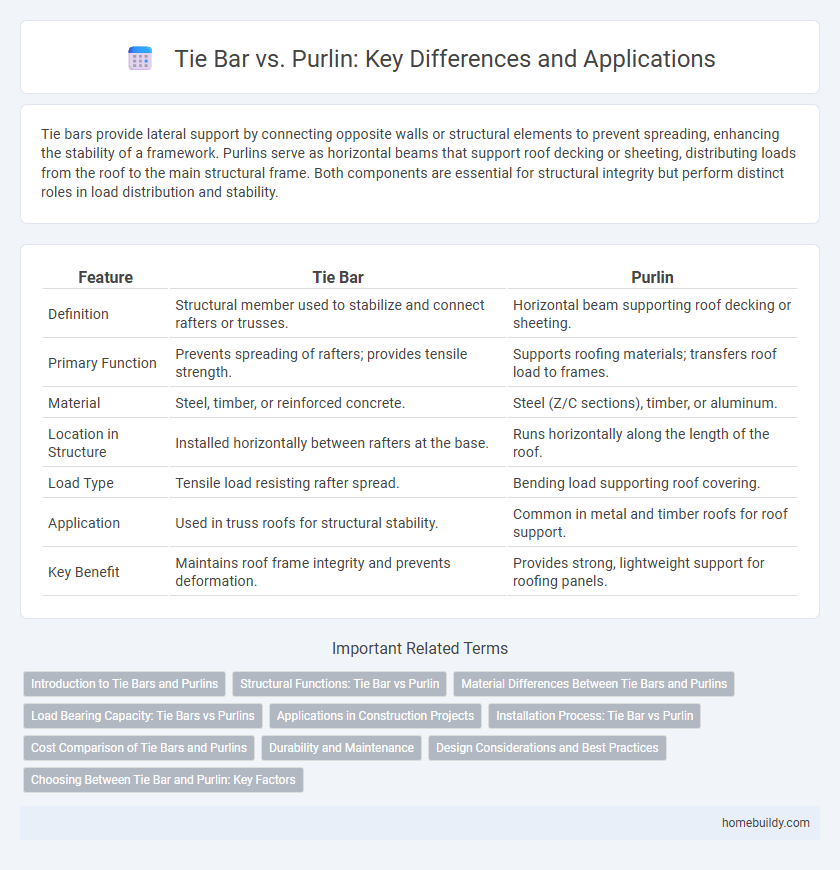Tie bars provide lateral support by connecting opposite walls or structural elements to prevent spreading, enhancing the stability of a framework. Purlins serve as horizontal beams that support roof decking or sheeting, distributing loads from the roof to the main structural frame. Both components are essential for structural integrity but perform distinct roles in load distribution and stability.
Table of Comparison
| Feature | Tie Bar | Purlin |
|---|---|---|
| Definition | Structural member used to stabilize and connect rafters or trusses. | Horizontal beam supporting roof decking or sheeting. |
| Primary Function | Prevents spreading of rafters; provides tensile strength. | Supports roofing materials; transfers roof load to frames. |
| Material | Steel, timber, or reinforced concrete. | Steel (Z/C sections), timber, or aluminum. |
| Location in Structure | Installed horizontally between rafters at the base. | Runs horizontally along the length of the roof. |
| Load Type | Tensile load resisting rafter spread. | Bending load supporting roof covering. |
| Application | Used in truss roofs for structural stability. | Common in metal and timber roofs for roof support. |
| Key Benefit | Maintains roof frame integrity and prevents deformation. | Provides strong, lightweight support for roofing panels. |
Introduction to Tie Bars and Purlins
Tie bars are structural components primarily used to provide lateral support and stabilize frameworks by connecting different elements and resisting tension forces. Purlins are horizontal beams placed across roof rafters, serving as a crucial support for roof sheeting and transferring loads to the primary structure. Understanding the distinct roles of tie bars and purlins is essential for designing efficient and stable roof and wall assemblies in construction.
Structural Functions: Tie Bar vs Purlin
Tie bars primarily serve as tension members that stabilize structural frames by preventing lateral movement and maintaining alignment under load, while purlins act as horizontal roof supports transferring loads from the roof deck to the main structural frame. Tie bars are essential in resisting tensile forces and ensuring structural integrity in truss and frame systems, whereas purlins provide continuous support and distribute weight evenly across roofing elements. Understanding the distinct structural roles of tie bars and purlins is crucial for optimizing load management and overall stability in construction design.
Material Differences Between Tie Bars and Purlins
Tie bars are typically made from high-strength steel to withstand tension forces in structural frameworks, ensuring stability and load distribution. Purlins, on the other hand, are often fabricated from galvanized steel or cold-formed steel sections designed to support roof decking by bearing compressive loads. The material selection reflects their distinct functions: tie bars prioritize tensile strength while purlins emphasize compressive resistance and corrosion protection.
Load Bearing Capacity: Tie Bars vs Purlins
Tie bars exhibit higher load-bearing capacity compared to purlins due to their tensile strength, effectively resisting horizontal forces and stabilizing structures under lateral loads. Purlins primarily support roof decking and transfer vertical loads to rafters or trusses but have limited capacity against tensile stress. Engineering designs favor tie bars in applications requiring enhanced structural integrity and resistance to eccentric loading.
Applications in Construction Projects
Tie bars are primarily used in concrete construction to provide tensile reinforcement and prevent structural separation, making them essential in walls, slabs, and beams. Purlins serve as horizontal supports in steel or timber roofing systems, distributing loads from the roof decking to the primary framing members. While tie bars enhance load-bearing capacity and joint stability within concrete elements, purlins optimize roof structure integrity and facilitate efficient load transfer in building envelopes.
Installation Process: Tie Bar vs Purlin
The installation process of a tie bar involves securing it horizontally between structural elements to provide lateral stability, typically requiring precise alignment and bolting or welding. Purlins are installed as longitudinal roof supports, laid across rafters or trusses, and are usually fastened using screws or clips, emphasizing rapid, repetitive placement to support decking or sheeting. Both components demand accurate measurement and secure fastening, but tie bars serve primarily for tension stabilization while purlins function as primary roof framing members.
Cost Comparison of Tie Bars and Purlins
Tie bars generally offer a more cost-effective solution compared to purlins due to lower material and installation expenses. Purlins, often made from heavier gauge steel or aluminum, tend to increase both upfront and maintenance costs. Selecting tie bars can significantly reduce structural support budgets while maintaining adequate strength and durability.
Durability and Maintenance
Tie bars offer superior durability compared to purlins due to their robust steel construction, which resists corrosion and deformation over time. Maintenance requirements for tie bars are minimal, often limited to periodic inspections and rust prevention treatments. In contrast, purlins, typically made from lighter materials, may require more frequent upkeep to address wear and structural integrity issues.
Design Considerations and Best Practices
Tie bars provide critical lateral support and tensile strength in roof framing systems, preventing purlin buckling under load. When designing, ensure tie bars are properly sized for tension forces and placed at optimal spacing to enhance purlin stability and overall structural integrity. Best practices include selecting corrosion-resistant materials and verifying connection details to maintain load transfer efficiency and durability.
Choosing Between Tie Bar and Purlin: Key Factors
Choosing between a tie bar and a purlin depends primarily on structural load requirements and roof design. Tie bars provide tensile support to prevent wall spread in trusses, while purlins offer transverse support for roofing sheets and distribute loads across rafters. Understanding span length, load type, and installation ease guides the selection to ensure structural stability and cost efficiency.
Tie bar vs Purlin Infographic

 homebuildy.com
homebuildy.com